Financial Reporting Assignment: Dynamics Co. Ltd Case Study Analysis
VerifiedAdded on 2021/04/19
|6
|956
|27
Report
AI Summary
This report analyzes the financial reporting of Dynamics Co. Ltd, a company engaged in the manufacture and distribution of premium security equipment. The assignment focuses on a non-current asset acquired on January 1, 2016, with a five-year useful life, depreciated using the straight-line method. The analysis involves calculating the Net Present Value (NPV) of the asset's cash flows and determining any impairment loss. The report details the computation of NPV, which is used to determine the recoverable amount, and compares it with the carrying amount to identify an impairment loss of $16,90,350. The report also mentions that the government will compensate up to 20% of the impairment loss, reducing the overall impact. The conclusion emphasizes the need to recognize the impairment loss in the financial statements according to IFRS. The report highlights the importance of understanding impairment loss and the application of depreciation methods in financial reporting.
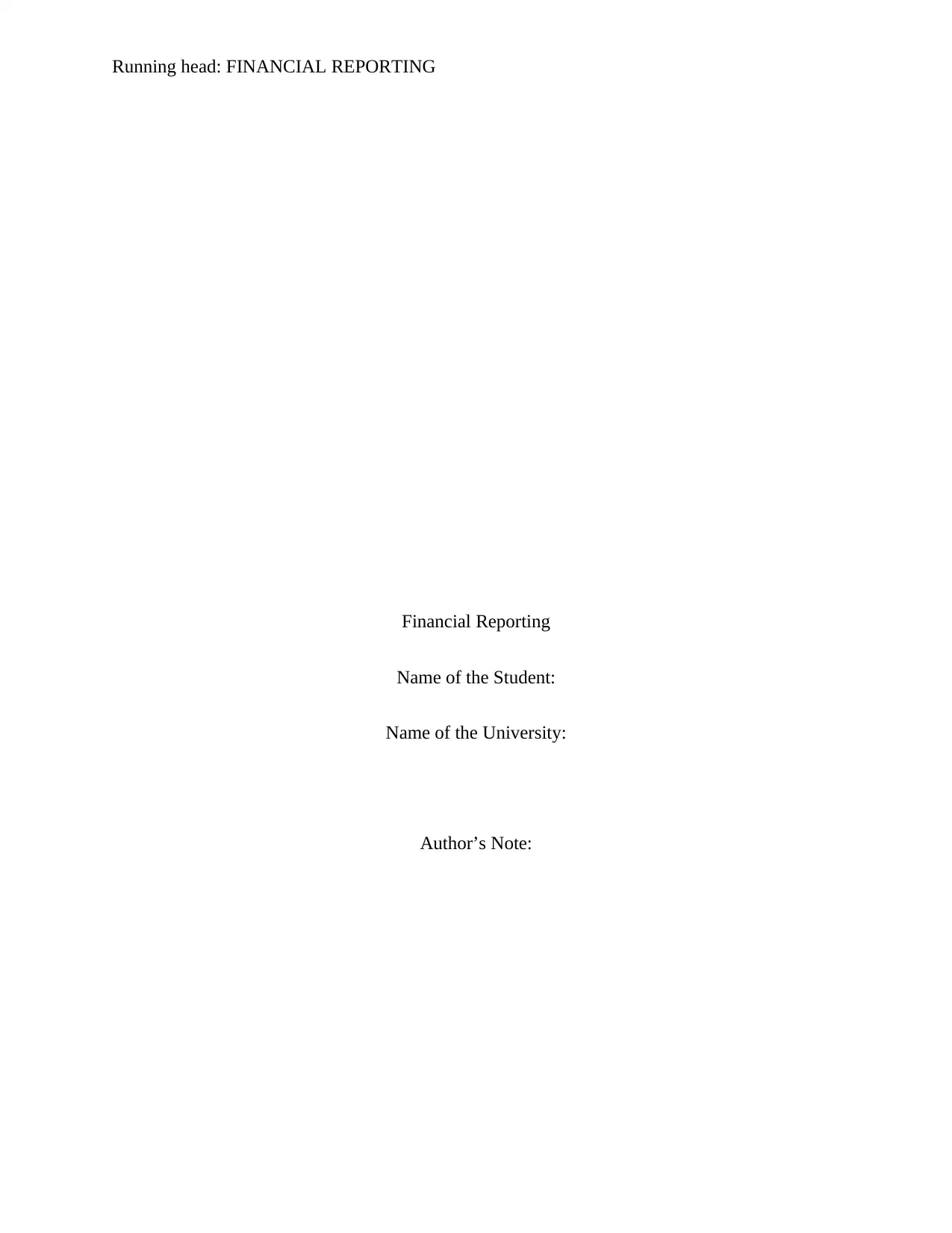
Running head: FINANCIAL REPORTING
Financial Reporting
Name of the Student:
Name of the University:
Author’s Note:
Financial Reporting
Name of the Student:
Name of the University:
Author’s Note:
Paraphrase This Document
Need a fresh take? Get an instant paraphrase of this document with our AI Paraphraser
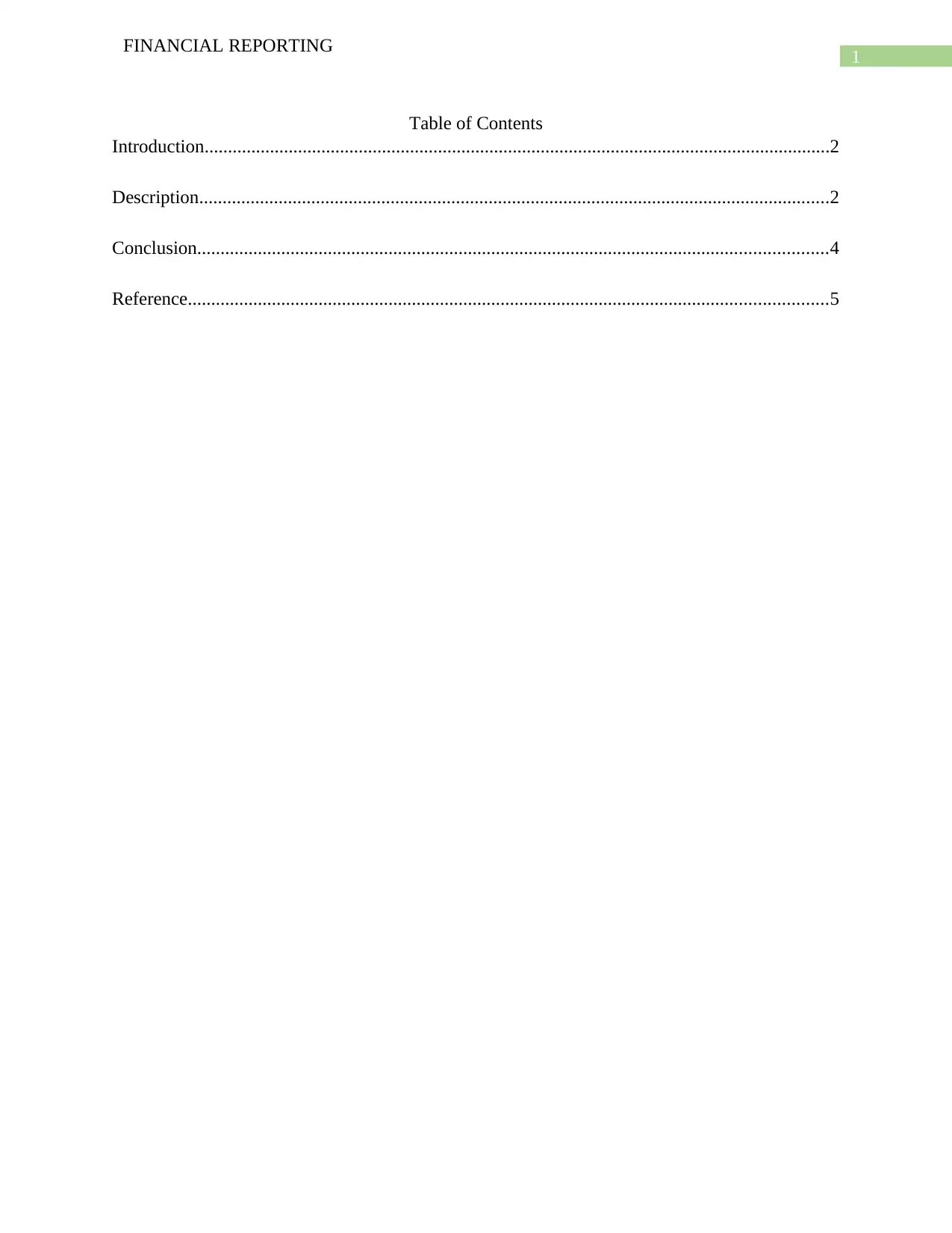
1
FINANCIAL REPORTING
Table of Contents
Introduction......................................................................................................................................2
Description.......................................................................................................................................2
Conclusion.......................................................................................................................................4
Reference.........................................................................................................................................5
FINANCIAL REPORTING
Table of Contents
Introduction......................................................................................................................................2
Description.......................................................................................................................................2
Conclusion.......................................................................................................................................4
Reference.........................................................................................................................................5
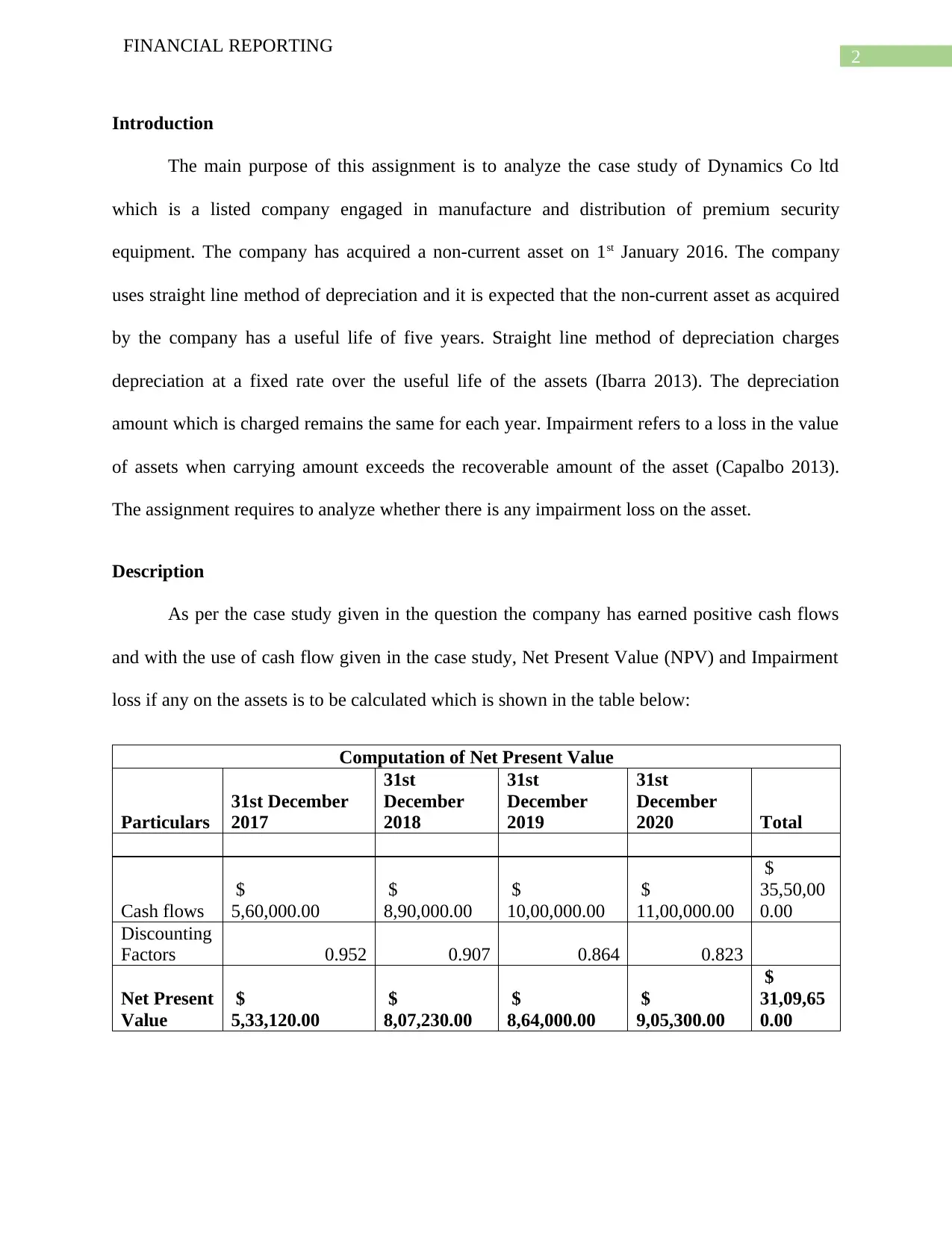
2
FINANCIAL REPORTING
Introduction
The main purpose of this assignment is to analyze the case study of Dynamics Co ltd
which is a listed company engaged in manufacture and distribution of premium security
equipment. The company has acquired a non-current asset on 1st January 2016. The company
uses straight line method of depreciation and it is expected that the non-current asset as acquired
by the company has a useful life of five years. Straight line method of depreciation charges
depreciation at a fixed rate over the useful life of the assets (Ibarra 2013). The depreciation
amount which is charged remains the same for each year. Impairment refers to a loss in the value
of assets when carrying amount exceeds the recoverable amount of the asset (Capalbo 2013).
The assignment requires to analyze whether there is any impairment loss on the asset.
Description
As per the case study given in the question the company has earned positive cash flows
and with the use of cash flow given in the case study, Net Present Value (NPV) and Impairment
loss if any on the assets is to be calculated which is shown in the table below:
Computation of Net Present Value
Particulars
31st December
2017
31st
December
2018
31st
December
2019
31st
December
2020 Total
Cash flows
$
5,60,000.00
$
8,90,000.00
$
10,00,000.00
$
11,00,000.00
$
35,50,00
0.00
Discounting
Factors 0.952 0.907 0.864 0.823
Net Present
Value
$
5,33,120.00
$
8,07,230.00
$
8,64,000.00
$
9,05,300.00
$
31,09,65
0.00
FINANCIAL REPORTING
Introduction
The main purpose of this assignment is to analyze the case study of Dynamics Co ltd
which is a listed company engaged in manufacture and distribution of premium security
equipment. The company has acquired a non-current asset on 1st January 2016. The company
uses straight line method of depreciation and it is expected that the non-current asset as acquired
by the company has a useful life of five years. Straight line method of depreciation charges
depreciation at a fixed rate over the useful life of the assets (Ibarra 2013). The depreciation
amount which is charged remains the same for each year. Impairment refers to a loss in the value
of assets when carrying amount exceeds the recoverable amount of the asset (Capalbo 2013).
The assignment requires to analyze whether there is any impairment loss on the asset.
Description
As per the case study given in the question the company has earned positive cash flows
and with the use of cash flow given in the case study, Net Present Value (NPV) and Impairment
loss if any on the assets is to be calculated which is shown in the table below:
Computation of Net Present Value
Particulars
31st December
2017
31st
December
2018
31st
December
2019
31st
December
2020 Total
Cash flows
$
5,60,000.00
$
8,90,000.00
$
10,00,000.00
$
11,00,000.00
$
35,50,00
0.00
Discounting
Factors 0.952 0.907 0.864 0.823
Net Present
Value
$
5,33,120.00
$
8,07,230.00
$
8,64,000.00
$
9,05,300.00
$
31,09,65
0.00
⊘ This is a preview!⊘
Do you want full access?
Subscribe today to unlock all pages.

Trusted by 1+ million students worldwide
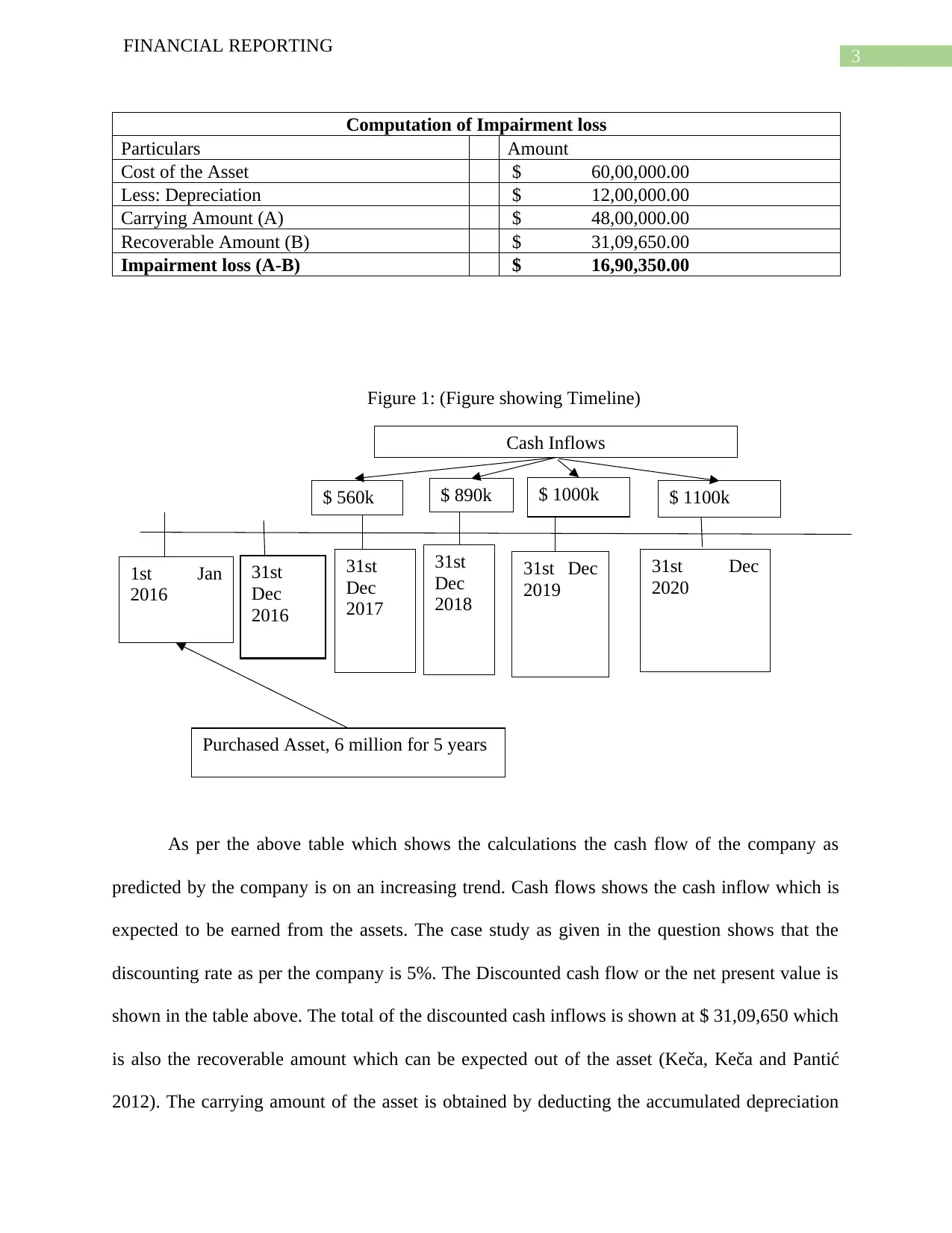
3
FINANCIAL REPORTING
31st
Dec
2016
31st
Dec
2017
31st
Dec
2018
31st Dec
2019
31st Dec
2020
Purchased Asset, 6 million for 5 years
1st Jan
2016
$ 560k $ 890k $ 1000k $ 1100k
Cash Inflows
Computation of Impairment loss
Particulars Amount
Cost of the Asset $ 60,00,000.00
Less: Depreciation $ 12,00,000.00
Carrying Amount (A) $ 48,00,000.00
Recoverable Amount (B) $ 31,09,650.00
Impairment loss (A-B) $ 16,90,350.00
Figure 1: (Figure showing Timeline)
As per the above table which shows the calculations the cash flow of the company as
predicted by the company is on an increasing trend. Cash flows shows the cash inflow which is
expected to be earned from the assets. The case study as given in the question shows that the
discounting rate as per the company is 5%. The Discounted cash flow or the net present value is
shown in the table above. The total of the discounted cash inflows is shown at $ 31,09,650 which
is also the recoverable amount which can be expected out of the asset (Keča, Keča and Pantić
2012). The carrying amount of the asset is obtained by deducting the accumulated depreciation
FINANCIAL REPORTING
31st
Dec
2016
31st
Dec
2017
31st
Dec
2018
31st Dec
2019
31st Dec
2020
Purchased Asset, 6 million for 5 years
1st Jan
2016
$ 560k $ 890k $ 1000k $ 1100k
Cash Inflows
Computation of Impairment loss
Particulars Amount
Cost of the Asset $ 60,00,000.00
Less: Depreciation $ 12,00,000.00
Carrying Amount (A) $ 48,00,000.00
Recoverable Amount (B) $ 31,09,650.00
Impairment loss (A-B) $ 16,90,350.00
Figure 1: (Figure showing Timeline)
As per the above table which shows the calculations the cash flow of the company as
predicted by the company is on an increasing trend. Cash flows shows the cash inflow which is
expected to be earned from the assets. The case study as given in the question shows that the
discounting rate as per the company is 5%. The Discounted cash flow or the net present value is
shown in the table above. The total of the discounted cash inflows is shown at $ 31,09,650 which
is also the recoverable amount which can be expected out of the asset (Keča, Keča and Pantić
2012). The carrying amount of the asset is obtained by deducting the accumulated depreciation
Paraphrase This Document
Need a fresh take? Get an instant paraphrase of this document with our AI Paraphraser
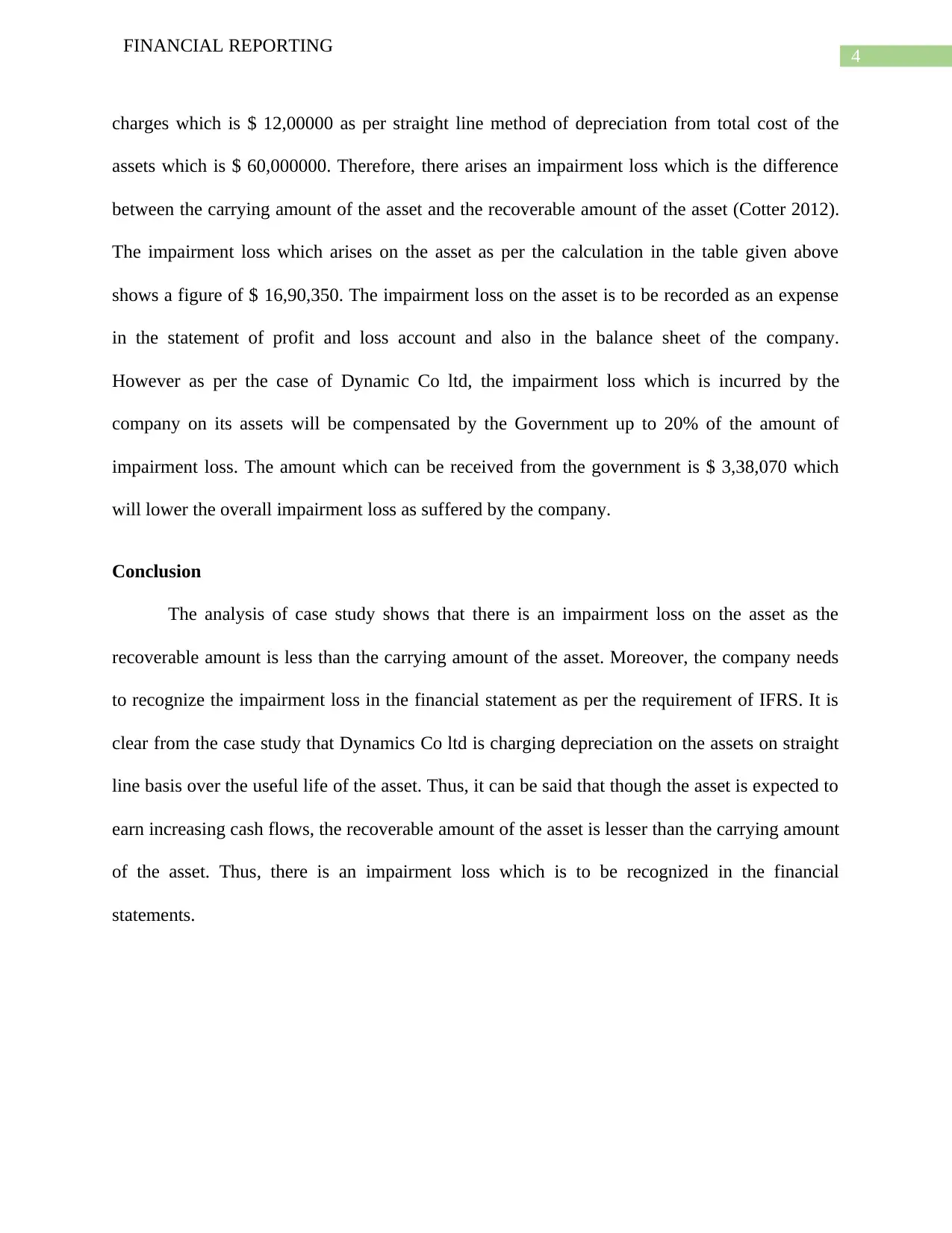
4
FINANCIAL REPORTING
charges which is $ 12,00000 as per straight line method of depreciation from total cost of the
assets which is $ 60,000000. Therefore, there arises an impairment loss which is the difference
between the carrying amount of the asset and the recoverable amount of the asset (Cotter 2012).
The impairment loss which arises on the asset as per the calculation in the table given above
shows a figure of $ 16,90,350. The impairment loss on the asset is to be recorded as an expense
in the statement of profit and loss account and also in the balance sheet of the company.
However as per the case of Dynamic Co ltd, the impairment loss which is incurred by the
company on its assets will be compensated by the Government up to 20% of the amount of
impairment loss. The amount which can be received from the government is $ 3,38,070 which
will lower the overall impairment loss as suffered by the company.
Conclusion
The analysis of case study shows that there is an impairment loss on the asset as the
recoverable amount is less than the carrying amount of the asset. Moreover, the company needs
to recognize the impairment loss in the financial statement as per the requirement of IFRS. It is
clear from the case study that Dynamics Co ltd is charging depreciation on the assets on straight
line basis over the useful life of the asset. Thus, it can be said that though the asset is expected to
earn increasing cash flows, the recoverable amount of the asset is lesser than the carrying amount
of the asset. Thus, there is an impairment loss which is to be recognized in the financial
statements.
FINANCIAL REPORTING
charges which is $ 12,00000 as per straight line method of depreciation from total cost of the
assets which is $ 60,000000. Therefore, there arises an impairment loss which is the difference
between the carrying amount of the asset and the recoverable amount of the asset (Cotter 2012).
The impairment loss which arises on the asset as per the calculation in the table given above
shows a figure of $ 16,90,350. The impairment loss on the asset is to be recorded as an expense
in the statement of profit and loss account and also in the balance sheet of the company.
However as per the case of Dynamic Co ltd, the impairment loss which is incurred by the
company on its assets will be compensated by the Government up to 20% of the amount of
impairment loss. The amount which can be received from the government is $ 3,38,070 which
will lower the overall impairment loss as suffered by the company.
Conclusion
The analysis of case study shows that there is an impairment loss on the asset as the
recoverable amount is less than the carrying amount of the asset. Moreover, the company needs
to recognize the impairment loss in the financial statement as per the requirement of IFRS. It is
clear from the case study that Dynamics Co ltd is charging depreciation on the assets on straight
line basis over the useful life of the asset. Thus, it can be said that though the asset is expected to
earn increasing cash flows, the recoverable amount of the asset is lesser than the carrying amount
of the asset. Thus, there is an impairment loss which is to be recognized in the financial
statements.
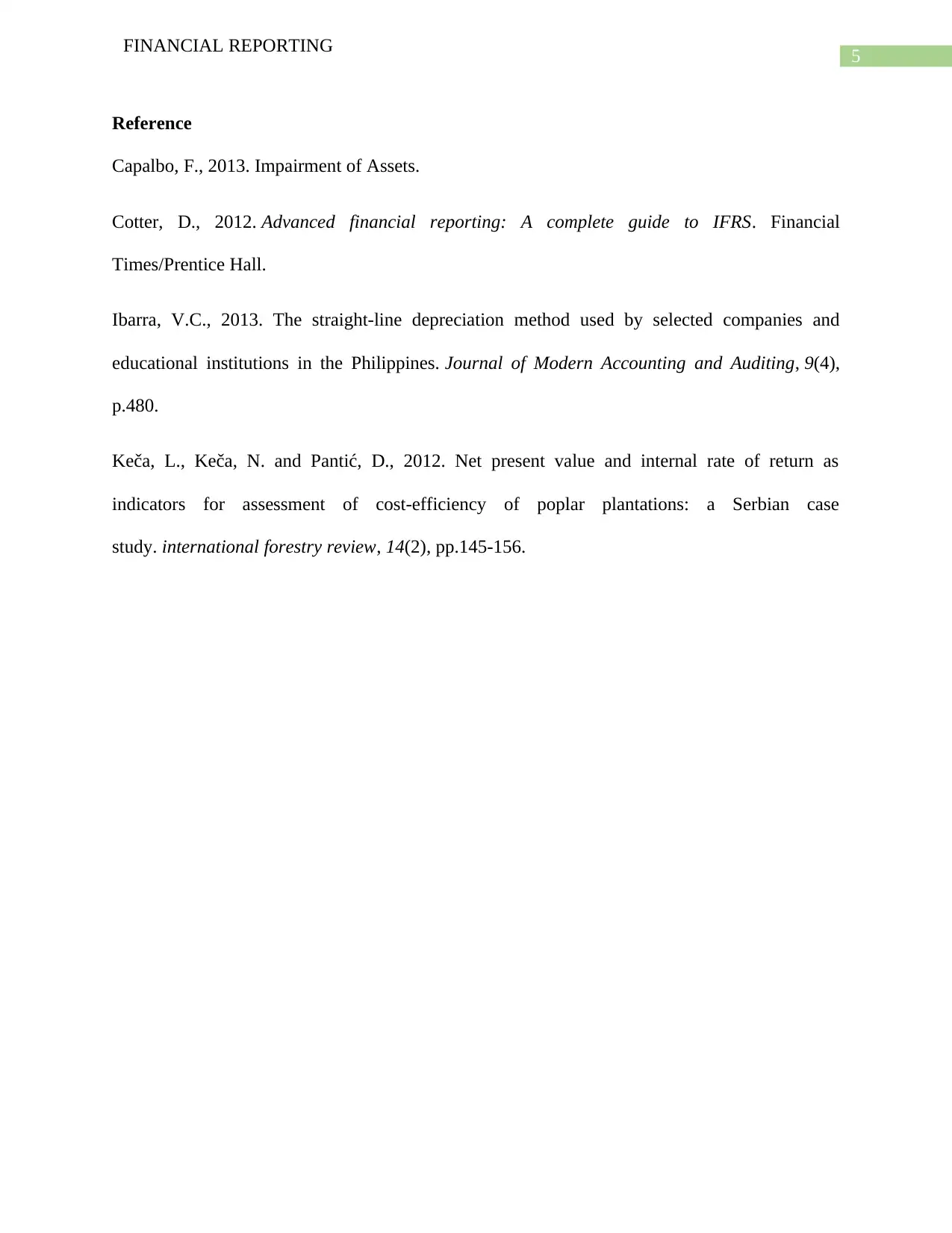
5
FINANCIAL REPORTING
Reference
Capalbo, F., 2013. Impairment of Assets.
Cotter, D., 2012. Advanced financial reporting: A complete guide to IFRS. Financial
Times/Prentice Hall.
Ibarra, V.C., 2013. The straight-line depreciation method used by selected companies and
educational institutions in the Philippines. Journal of Modern Accounting and Auditing, 9(4),
p.480.
Keča, L., Keča, N. and Pantić, D., 2012. Net present value and internal rate of return as
indicators for assessment of cost-efficiency of poplar plantations: a Serbian case
study. international forestry review, 14(2), pp.145-156.
FINANCIAL REPORTING
Reference
Capalbo, F., 2013. Impairment of Assets.
Cotter, D., 2012. Advanced financial reporting: A complete guide to IFRS. Financial
Times/Prentice Hall.
Ibarra, V.C., 2013. The straight-line depreciation method used by selected companies and
educational institutions in the Philippines. Journal of Modern Accounting and Auditing, 9(4),
p.480.
Keča, L., Keča, N. and Pantić, D., 2012. Net present value and internal rate of return as
indicators for assessment of cost-efficiency of poplar plantations: a Serbian case
study. international forestry review, 14(2), pp.145-156.
⊘ This is a preview!⊘
Do you want full access?
Subscribe today to unlock all pages.

Trusted by 1+ million students worldwide
1 out of 6
Related Documents
Your All-in-One AI-Powered Toolkit for Academic Success.
+13062052269
info@desklib.com
Available 24*7 on WhatsApp / Email
![[object Object]](/_next/static/media/star-bottom.7253800d.svg)
Unlock your academic potential
Copyright © 2020–2025 A2Z Services. All Rights Reserved. Developed and managed by ZUCOL.





